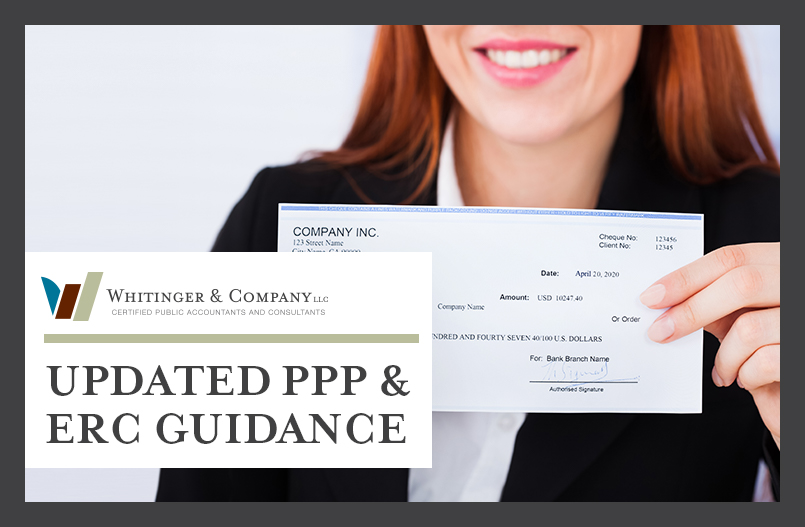Last week was a busy week at the IRS and SBA. The SBA issued additional guidance regarding Paycheck Protection Program loans, while the IRS issued guidance regarding the Employee Retention Credit. Not to be outdone, Congress included additional changes to the Paycheck Protection Program and the Employee Retention Credit in the American Rescue Plan Act (ARPA) that was passed by the Senate last weekend and the by the house yesterday. President Biden is expected to sign the bill later today. The highlights are summarized below:
Paycheck Protection Program
The new interim final rule allows individuals who file an IRS Form 1040, Schedule C to calculate their maximum loan amount using gross income, with some modifications, instead of net income. This can significantly increase the maximum loan amount or allow borrowers who were otherwise ineligible to qualify. Borrowers using the alternative calculation and that report more than $150,000 in gross income should consider documenting need, as they do not automatically qualify for the good faith safe harbor. The exact mechanics of the calculation are included in the interim final rule.
The interim final rule also removes the eligibility restriction that prevents businesses with owners who have non-financial fraud felony convictions in the last year from obtaining PPP loans, and removes the eligibility restriction that prevents businesses with owners who are delinquent or in default on their Federal student loans from obtaining PPP loans. The ARPA expands eligibility for nonprofits and internet-only publishers.
The current PPP loan deadline is March 31, 2021, and many lenders are imposing earlier submission deadlines, so borrowers need to act fast.
Link to the new interim final rule: https://home.treasury.gov/system/files/136/PPP-IFR-Loan-Amount-Calculation-and-Eligibility.pdf
Employee Retention Credit
The Employee Retention Credit (ERC) was originally a part of the CARES Act passed last spring. The ERC generally allowed for a 50% credit on qualified wages an eligible employer paid to employees after March 12, 2020 and before January 1, 2021. The maximum credit was $5,000 per employee. However, most small businesses were unable to take advantage of the ERC because they had to choose either a PPP loan or the ERC. For almost all small businesses, the PPP loan was the better answer.
In late December 2020, Congress passed legislative changes to the ERC. One of those changes allowed small businesses to retroactively claim the ERC, even if they had already received a PPP loan. Congress also extended the credit through the first two quarters of 2021, increased the maximum credit amount per employee for 2021, and made it easier to qualify for the credit in 2021. Congress also instructed the IRS to issue additional guidance. The IRS responded by releasing Notice 2021-20 last week. The Notice provided guidance related to the ERC for qualified wages paid after March 12, 2020 and before January 1, 2021. The IRS intends to release guidance related to the ERC for qualified wages paid in 2021 at a future date. The ARPA extends the ERC and makes additional changes.
For 2020, the ERC rules are summarized as follows:
- Refundable credit against certain employment taxes equal to 50% of the qualified wages an eligible employer paid to employees after March 12, 2020 and before January 1, 2021
- For each employee, wages (including certain health plan costs) up to $10,000 can be counted to determine the amount of the 50% credit
- wages used to qualify for PPP loan forgiveness or FFCRA paid leave credits do not qualify
- employers who have not yet submitted their PPP loan forgiveness applications should discuss with their accountant before doing so
- Employers, including tax-exempt organizations, are eligible for the credit if they experienced either:
- the full or partial suspension of the operations of their trade or business during any calendar quarter because of governmental orders limiting commerce, travel or group meetings due to COVID-19, or
- a significant decline in gross receipts
- a significant decline in gross receipts begins on the first day of the first calendar quarter of 2020 for which gross receipts are less than 50% of the gross receipts for the same calendar quarter in 2019.
- a significant decline in gross receipts ends on the first day of the first calendar quarter following the calendar quarter in which gross receipts are more than 80% of gross receipts for the same calendar quarter in 2019.
- The definition of qualified wages depends on how many employees an eligible employer had
- If 100 of fewer full-time employees during 2019, qualified wages are generally wages paid to any employee during the period operations were suspended or the period of the decline in gross receipts
- If more than 100 full-time employees during 2019, qualified wages are generally wages paid to employees that are not providing services because operations were suspended or due to the decline in gross receipts
For 2021, the ERC rules are summarized as follows:
- Refundable credit against certain employment taxes equal to 70% of the qualified wages an eligible employer pays to employees after December 31, 2020 and before January 1, 2022
- For each employee, wages (including certain health plan costs) up to $10,000 per quarter can be counted to determine the amount of the 70% credit
- wages used to qualify for PPP loan forgiveness or FFCRA paid leave credits do not qualify
- employers who have not yet submitted their PPP loan forgiveness applications should discuss with their accountant before doing so
- Employers, including tax-exempt organizations, are eligible for the credit if they experience either:
- the full or partial suspension of the operations of their trade or business during any calendar quarter because of governmental orders limiting commerce, travel or group meetings due to COVID-19, or
- a significant decline in gross receipts
- a significant decline in gross receipts begins on the first day of the first calendar quarter of 2021 for which gross receipts are less than 80% of the gross receipts for the same calendar quarter in 2019.
- a significant decline in gross receipts ends on the first day of the first calendar quarter following the calendar quarter in which gross receipts are more than 80% of gross receipts for the same calendar quarter in 2019.
- For 2021 only, the significant decline in gross receipts test can be satisfied by looking at the immediately preceding calendar quarter (i.e. comparing Q4 2020 to Q4 2019 to qualify for ERC in Q1 2021)
- The definition of qualified wages depends on how many employees an eligible employer has:
- If 500 or fewer full-time employees during 2019, qualified wages are generally wages paid to any employee during the period operations were suspended or the period of the decline in gross receipts
- If more than 500 full-time employees during 2019, qualified wages are generally wages paid to employees that are not providing services because operations were suspended or due to the decline in gross receipts
There are many additional rules, exceptions, etc. that apply to the ERC, so please do not hesitate to reach out if you believe you may qualify or if you have any questions. You can also access the link to Notice 2021-20 here: https://www.irs.gov/pub/irs-drop/n-21-20.pdf
We are here and ready to help.



